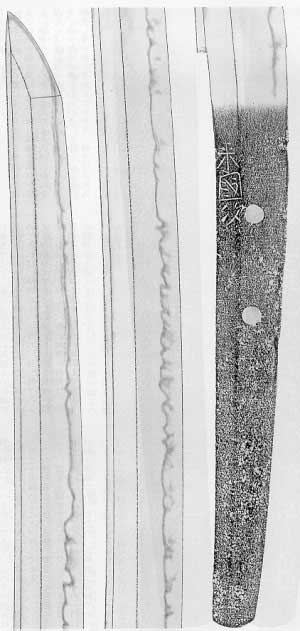NYUSATSU-KANTEI-TO OF THE 41ST ANNUAL CONVENTION
No.1 Tachi
| Mei: | “RAI KUNITSUGU” |
| Ha-watari: | 74.1 cm |
| Sori: | 3.35 cm |
| Shinogi-zukuri | |
| Iori-mune | |
| Jihada: |
Fine
and dense ko-itame-hada combined with black and plain hada and running
o-hada in places in company with thick ji-nie and fine chikei then
faint nie-utsuri appears.
|
|
| Hamon: |
Sugu-ha
tends to be gentle notare then mixes ko-choji and ko-gunome. Ko-saka-ashi
are seen in some parts of the haki-omote then ashi, yo and mune-yaki
(in the bottom area) are seen. It consists of thick ko-nie and the
nioi-guchi is very bright.
|
|
| Boshi: |
Narrow
sugu then turns back in ko-maru with very short kaeri.
|
The blade has a little slender mi-haba, funbari, torii-zori or Ko-zori and dignified tachi-sugata with chu-kissaki. The jihada is most finely forged except the running o-hada then it is covered with abundant ji-nie. The hamon is in ko-nie-deki and tempered in small pattern that mixes ko-choji and ko-gunome. Also Ko-saka-ashi and mune-yaki are the decisive factors to attribute to one of the Rai school. Though it appears to have been difficult to go to Rai Kunitsugu since it is one of his early works and does not show his typical workmanship. Therefore many votes went to Rai Kunitoshi, Ryokai, Rai Kuniyuki and Rai Kunimitsu in addition to votes for smiths of the Enju school. Only two persons hit Rai Kunitsugu this time. Votes for Rai Kunitoshi, Ryokai and Rai Kunimitsu were give ‘Atari’ and votes for Rai Kuniyuki and Niji Kunitoshi ‘Dozen then votes for smiths of the Enju school ‘Jun-dozen’.
Niji Kunitoshi makes tachi-sugata with wide mi-haba and choji is more emphasized. Rai Kuniyuki tempers hamon in more complicated pattern and it mixes a unique midare called ‘karimata’ (fish-tail shaped midare) and his workmanship looks somewhat classical on the whole. Voting for the Enju school is not bad idea though their nioi-guchi and their jigane are inferior to those of Kunitsugu in brightness and clearness.
Apart from ‘Atari’ and ‘Dozen’, there were many votes for the Ko-aoe school then some votes for the Ko-bizen, Ukai and Awataguchi (Kunitomo, Hisakuni and Kuniyasu) schools.
It seems that people who voted for the Ko-aoe school mixed up the plain hada that looks like jifu with sumi-hada of the Aoe school. It is important to judge if this hada is original one or the result of tiredness. Taking a careful look at the blade, it has scarce hira-niku and becomes to know that it has lost hira-niku after many polishes. Jihada of the Ko-aoe school becomes unique mokume-hada called chirimen-hada then sumi-hada is combined in places. In addition, these older smiths should make tachi-sugata with deep sori but the sori becomes almost straight from the monouchi area, and the Ko-aoe and Ko-bizen schools produce irregular and dark jifu-utsuri also the Ukai school does different utsuri.
Incidentally, Kunitsugu signs in small characters with thin chiseling and uses a character of ‘Kuni’ with the shorter side at the top. This is very rare extant tachi of Rai Kunitsugu with ubu-nakago and it gives us a lot of valuable information to study this smith.
